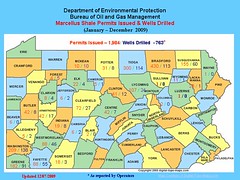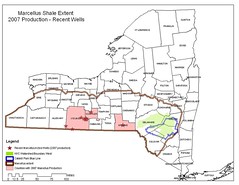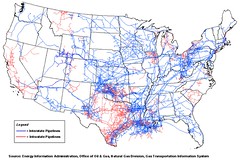By DAVID THOMPSON
(Williamsport, PA) sungazette.com
February 1, 2010
Pennsylvania has its work cut out for it regarding the treatment and disposal of flowback fluids from drilling in the Marcellus Shale, it was revealed during a summit Friday at Lycoming College.
That was one of several topics discussed at "The Science of the Marcellus Shale" summit, a daylong event sponsored by the college's Clean Water Institute, the Susquehanna Heartland Coalition for Environmental Studies, Northcentral Pennsylvania Conservancy and Foundation for Pennsylvania Watersheds.
...
The gas industry requires large amounts of water - several million gallons per well - to extract gas from the Marcellus Shale.
Although much of that water will remain in the ground, the industry still faces challenges in finding efficient and cost effective ways to treat and dispose of the water that does return to the surface.
Each well drilled in the Marcellus Shale will produce from 200,000 to 1 million gallons of flowback water, according to Tim Keister, founder and chief chemist of Brockway-based ProChem Tech, a company that makes chemicals for wastewater treatment.
Treatment capacity limited
The capacity for treating that water in Pennsylvania is limited, Keister said.
Frac water is water with a number of materials added to it, he said. The most problematic of the ingredients is a biocide used to prevent micro-organisms from growing in the well, he said.
"Biocides kill things," Keister said.
Unfortunately, there is "a big shortfall" in the state's capacity to treat gas drilling wastewater," Keister said.
The industry will produce an estimated 7 billion gallons of wastewater a year, while the state's capacity for handling the water is about 550 million gallons - 6,450 million gallons "you have to find a home for," he said.
Treatment technologies include pretreatment so conventional wastewater treatment processes can efficiently treat the waste; chemical precipitation, which involves adding chemicals to the wastewater to form particles that settle and remove contaminants; and evaporation, an expensive process.
Marcellus Shale flowback water contains very high levels of salt, which cannot be removed through normal wastewater treatment processes, said Kevin Gilmore, a professor at Bucknell University.
Gilmore discussed technologies being explored to treat flowback water, such as a process in which the water is pushed through a non-porous membrane and permeates through the other side. It is yet to be seen if the process can be applied on a scale that can benefit the gas industry, he said.
A similar process, reverse osmosis, is energy intensive and does not get water to the point at which it can be discharged, he said.
Richard Adams, senior environmental adviser for Texas-based Chief Oil and Gas, said his company has drilled 45 wells in the shale, 13 of which are producing commercially. The company has 550,000 acres leased in the shale region, he said.
The company is withdrawing about 100,000 gallons of water a day from various creeks and public water supplies in the area, Adams said.
An average of about 20,000 gallons of wastewater must disposed of each day, he said. The wastewater is treated at a public treatment facility in Sunbury and at a private facility in Williamsport, where it is pre-treated before being discharged into the city sanitary sewer system.
Adams, who worked for more than 30 years for the state Department of Environmental Protection, said managing gas industry wastewater is complicated. Wastewater can be pre-treated, treated at a high-tech centralized treatment facility, treated on-site by a mobile treatment facility or, in the case of solids removed from the water, buried in an approved landfill.
Because it is expensive to transport wastewater to treatment facilities, gas companies are looking more and more to recycling and reusing the water, Adams said.
Recycling can save gas companies "tens of thousands of dollars ... per well," he said.
To recycle flowback water, it is kept at the well pad, reconditioned with an additive and reused to frac the next well by blending it with fresh water, he said.
Recycling and reuse is the least expensive method of dealing with wastewater, Adams said. However, there are concerns using recycled frac water to stimulate a well may adversely impact the well's production capabilities.
Adams said the majority of Chief's drilling operations are using flowback recycling "in one form or another."
Recycling also reduces the industry's need for fresh water, he said.
"You are going to see increased levels of reuse," he said. "It just makes sense."
Even with recycling, there still will be a need to treat and dispose of frac water and materials removed from the water, he said. A time will come when recycled water is no longer fit to be used, or there may not be another well ready to be fraced.
Although there are several options available to treat and dispose of flowback, one that is not available is injection wells.
The state's injection wells simply do not have the capacity for the large volume of flowback fluids anticipated from developing the Marcellus Shale, said Karen Johnson, chief of Groundwater and Enforcement Branch of the U.S. Environmental Protection Agency's Underwater Injection Control Program. The EPA oversees the underground injection well program in Pennsylvania, she said.
Private well testing urged
Bryan Swistock of Penn State Cooperative Extension discussed private water well testing. There are about 3 million property owners in the state who use a private well or spring as a drinking water supply, Swistock said.
Swistock said the extension has been "begging and pleading" for homeowners to have their water tested, but not many did. Since the Marcellus Shale began being developed, 2 million wells have been tested, he said.
Depending on what a homeowner desires, testing can be inexpensive or cost hundreds of dollars "to have everything tested," he said.
Swistock said a good basic and inexpensive test could include total dissolved solids, pH content, chloride and methane.
Swistock said homeowners should learn where and when drilling will occur and then monitor their wells if it is occurring nearby. They should understand the type of testing they should have done, he said.
"Focus on what is most likely to occur for the least cost," he said.
According to Swistock, if a private water supply within 1,000 feet of a gas well becomes adversely impacted within six months of the well being drilled, the law automatically presumes the gas well caused the problem.
However, the homeowner must have had the well tested by an independent lab prior to the well being drilled, he said.
No "presumed responsibility" law exists regarding a stream, pond or lake, Swistock said. However, a landowner can stipulate those protections into a gas lease.
Concerns about water treatment are coupled with concerns about the amount of water the industry needs to develop the shale.
The Susquehanna River Basin Commission is a multi-state compact that regulates and enforces water withdrawal and consumptive use of water in the states in the watershed.
Consumptive use is defined as any use in which water is not returned to its source.
The commission requires a permit for the consumption of an average of 100,000 gallons per day over 30 days, according to Jennifer Hoffman, of the commission.
That rule applies to any person or industry wishing to use that amount of water, Hoffman said. No such threshold exists for gas development in the Marcellus Shale.
"For Marcellus activities, we start regulating at drop one," Hoffman said.
So far, all permits issued for withdrawal by gas companies has been for surface water, such as streams, lakes and rivers, Hoffman said. No groundwater withdrawal permits have been issued.
For a permit to be issued, an environmental screening must be performed to determine whether the withdrawal will impact the body of water.
The commission also has water intake standards to prevent fish from being drawn into the intake pipes and metering plans to ensure companies withdraw only the amount permitted, Hoffman said.
Allowed withdrawals are based on what is called "Q 7,10" - or the lowest average flow a stream could experience over seven consecutive days during a 10-year span. Only a fraction of the Q 7,10 level for any given body of water can be withdrawn, Hoffman said.
Certain high-quality streams, particularly coldwater trout streams, have an assigned "passby level," which protects streams during times of low volume. Passby is the level of water flow that must be maintained downstream from an intake pipe, Hoffman said.
Once a stream reaches the predetermined passby level, "water can't be withdrawn anymore," she said.
Although the gas industry requires large amounts of water, the total used by the entire industry pales in comparison to a single nuclear power plant, which can use more than 40 million gallons of water every day, Hoffman said.
Trout stream worries
Deb Nardone, of the Pennsylvania Council of Trout Unlimited, said many of the organization's members are concerned about the industry's impact on trout stream habitat.
The organization's position on gas exploration is "let's do it, but let's do it right," Nardone said.
"We understand (gas) is not going away ... and it will require a whole lot of water," she said.
Nardone said the presence of trout in a stream is "the canary in the coal mine" that can be indicative of a healthy ecosystem.
Better regulatory protections are in place for trout streams and connected wetlands, Nardone said.
There are concerns withdrawing water may open a stream up to invasive species and diseases transported from tanker trucks from one stream to another.
There also are concerns with withdrawing water during certain times of the year, such as when eggs are being incubated or trout are spawning, she said.
Nardone said the organization is recommending seasonal restrictions on water consumption, technologies and methods to reduce consumption, mandatory flow monitoring devices, assessing streams prior to withdrawals, metered intakes, water pumps designed to prevent stream disturbance and fish mortality, and disinfection protocols to prevent the spread of disease and invasive species.
To read more, CLICK HERE.


















No comments:
Post a Comment